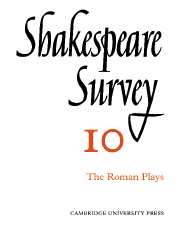Book contents
- Frontmatter
- Shakespeare’s Roman Plays: 1900–1956
- Shakespeare’s ‘Small Latin’—How Much?
- Shakespeare and the Elizabethan Romans
- The Metamorphosis of Violence in Titus Andronicus
- From Plutarch to Shakespeare: A Study of Coriolanus
- The Composition of Titus Andronicus
- Classical Costume in Shakespearian Productions
- Shakespeare’s Use of a Gallery over the Stage
- Lear’s Questions
- “Egregiously an Ass”: The Dark Side of the Moor. A view of Othello’s Mind
- Shakespeare in Schools
- Shakespeare Festival, Toronto, Canada
- International Notes
- Shakespeare Productions in the United Kingdom: 1955
- Drams of Eale, A Review of Recent Productions
- The Year's Contributions to Shakespearian Study 1 Critical Studies
- 2 Shakespeare’s Life, Times and Stage
- 3 Textual Studies
- Books Received
- Index
- Plate Section
The Metamorphosis of Violence in Titus Andronicus
Published online by Cambridge University Press: 28 March 2007
- Frontmatter
- Shakespeare’s Roman Plays: 1900–1956
- Shakespeare’s ‘Small Latin’—How Much?
- Shakespeare and the Elizabethan Romans
- The Metamorphosis of Violence in Titus Andronicus
- From Plutarch to Shakespeare: A Study of Coriolanus
- The Composition of Titus Andronicus
- Classical Costume in Shakespearian Productions
- Shakespeare’s Use of a Gallery over the Stage
- Lear’s Questions
- “Egregiously an Ass”: The Dark Side of the Moor. A view of Othello’s Mind
- Shakespeare in Schools
- Shakespeare Festival, Toronto, Canada
- International Notes
- Shakespeare Productions in the United Kingdom: 1955
- Drams of Eale, A Review of Recent Productions
- The Year's Contributions to Shakespearian Study 1 Critical Studies
- 2 Shakespeare’s Life, Times and Stage
- 3 Textual Studies
- Books Received
- Index
- Plate Section
Summary
It is surprising to find Shakespearian critics in agreement, yet almost to a man they have concurred in their verdict on the merits of Titus Andronicus. The word which most nearly sums up their feelings is “disgust”. Ravenscroft called the play “a heap of rubbish” Coleridge said that it was “obviously intended to excite vulgar audiences by its scenes of blood and horror—to our ears shocking and disgusting”; Dover Wilson recently called it a “broken-down cart, laden with bleeding corpses from an Elizabethan scaffold”. Only a few critics have had so much as a word of praise for this early Shakespearian tragedy.
The features of Titus Andronicus which have had such enduring power to repel the critics are easy to identify. The succession of extraordinarily violent episodes has given rise to the opinion that the play is crude—fit only for "vulgar audiences". The florid style of many of the speeches has seemed appallingly overwrought. Now it is a curious fact that this second feature should logically lead to a quite different opinion about the play. Miss M. C. Bradbrook has well characterized the tone as "cool and cultured".4 If the style is crude in a way, it is not the crudity of the bear-baiting pit or the Elizabethan scaffold. The trouble seems to be an excess of refinement, or an overloading with classical allusion—surely caviare for the bear-baiting crowd.
- Type
- Chapter
- Information
- Shakespeare Survey , pp. 39 - 49Publisher: Cambridge University PressPrint publication year: 1957
- 4
- Cited by

